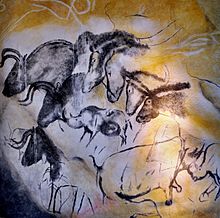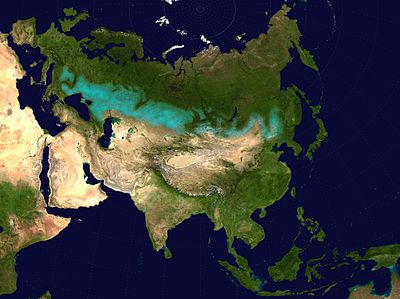Grassland
![]()
This article is about natural grassland as opposed to man-made and used grassland.
Grassland (also primeval grassland) is often used, especially in vegetation science, as a generic term for the natural grassland on which, due to climatic conditions, predominantly grass and/or herbaceous plants (can) grow. The largest proportion of the terrestrial land surface is occupied by such grassy open land biomes in which trees are absent or play a subordinate role.
Primary grasslands occur predominantly in regions where less than 400 mm of precipitation falls on an annual average and therefore no natural succession towards scrubland and woodland takes place. These include the prairies of North America, the pampas of South America, the Eurasian steppe, the grasslands of Australia, as well as the dry savannas throughout the tropical belt, the grassland tundras in some Arctic regions and the highland steppes in the American Cordillera and the Asian high mountains such as in Anatolia or Tibet.
In transitional areas to woodlands and in (apparently natural) grasslands with rainfall well above 400 mm per year, the emergence of grasslands is often attributed to the centuries-long influence of large grazing herds of wild animals (megaherbivore theory) or the herds of pastoral peoples.
Due to climatic conditions, sparse vegetation or their remoteness, grassland biotopes can usually only be used as extensive pasture farming land (pastoralism). In the past, this was done by non-sedentary nomads (nomadism), today mainly by semi-sedentary or sedentary mobile livestock farmers.

Bison herd, prairie, Montana (2008)

Ice Age cave painting of grazers of subtropical climates, Chauvet Cave, Ardèche, southern France (ca. 30,000 - 22,000 BC).
Examples of grassland ecosystems
- Meadow tundras, sub-areas of tundras in the Arctic of North America and Siberia.
- Steppes
- Eurasian steppe, home to herds of Przewalski's horses, the Asiatic donkey and the saiga antelope, and in historical times to equestrian peoples such as the Golden Horde.
- Puszta in Hungary, whose existence can possibly not be explained climatically, but only anthropogenically.
- Pontokaspis, named after the ancient name of the Black Sea (Pontos Euxeinos), or Wild Field, has always been, without geographical barriers, a transit area for numerous equestrian peoples.
- Starvation steppe or Kazakh steppe, a steppe-like semi-desert in central Kazakhstan.
- Mats in the alpine altitudinal zone of the Alps and other humid mountains.
- Highland steppes in the American Cordilleras (Páramo and Puna in the Andes) as well as the mountains of Central Asia, especially the highlands of Tibet.
- Great Plains, the classic prairies of the North American West, which were home to several million American bison and the Plains Indians who established a nomadic equestrian culture with the help of the horse introduced from Europe.
- former mammoth steppes of the ice age.
- Savannahs
- Serengeti, a low-tree savanna east of Lake Victoria and other dry savannahs of Africa that are the habitat of vast herds of wild grazing animals that undertake extensive seasonal migrations.
- Grasslands of Australia
- Grass Savannah
· 
Grassland steppe with flock of sheep and shepherd, Kazakhstan, June 2011
·
Grass savannah in Burkina Faso
· 
Kansas prairie
· 
Alaskan meadow tundra
·
Wildebeest herd, Masai Mara savannah, Kenya

enlarge and show information about the picture
![]()
Grassland of the Altai

Eurasian grass steppe (light blue) from the Puszta near Vienna in the west to Manchuria in the east
Cultivated Grassland
→ Main article: Grassland
Cultivated grassland or grassland is not primeval grassland. It was created by nature-exploiting agriculture without site-conserving or site-improving management in areas whose climax vegetation is primarily forests. Over the last 200 years, more intensive agriculture has created what is known as cultivated grassland by regulating the water and nutrient balance, introducing productive plant species and regulating land-use processes. If management is too intensive, this overuse leads to a loss of biotope and structural diversity and results in more unstable ecosystems.
Traditionally managed grasslands are often biologically very diverse ecosystems. Especially in the conservation of traditional grassland types, nature conservation goes very closely hand in hand with the protection of cultural landscapes. In the case of remnants of former cultural forms, their value as cultural heritage is still neglected.
To date, good agricultural practice (GAP) has led to the loss and endangerment of biodiversity and soil fertility.
Questions and Answers
Q: What is a grassland?
A: A grassland is a biome that mostly has grasses with some wild grasses and trees.
Q: Where are grasslands found?
A: Grasslands are found in Africa, North America, Central Asia, South America, and near the coasts of Australia.
Q: What is the largest grassland in the world?
A: The largest grasslands are in East Africa.
Q: What are grasslands with a few scattered trees called?
A: Grasslands with a few scattered trees are called savannas.
Q: What are some other names for grasslands?
A: Others names for grasslands are prairies or steppes.
Q: What constitutes a biome?
A: A biome is an area of land that has its own unique climate, plants, and animals.
Q: Are grasslands exclusive to any one location?
A: No, grasslands are found in several parts of the world.
Search within the encyclopedia

